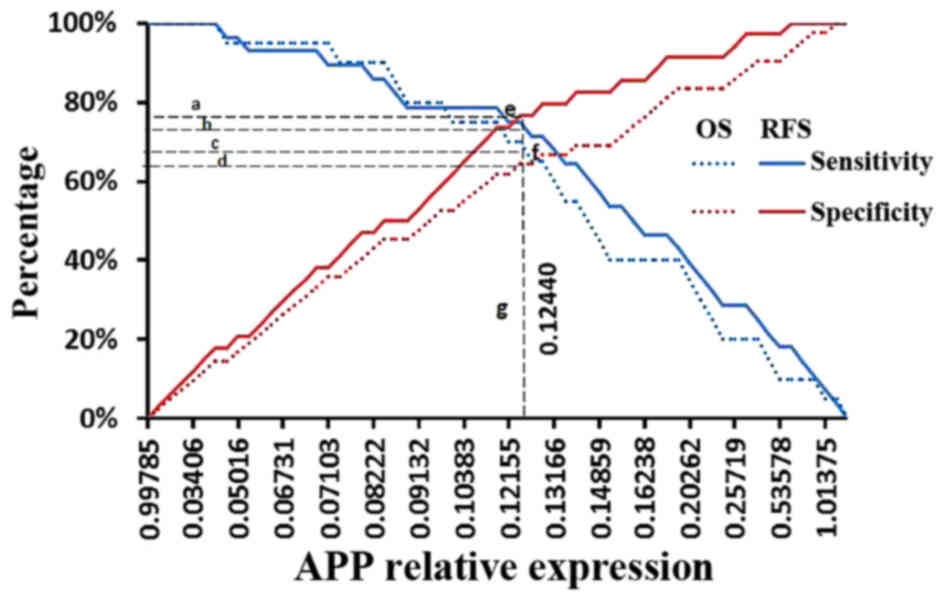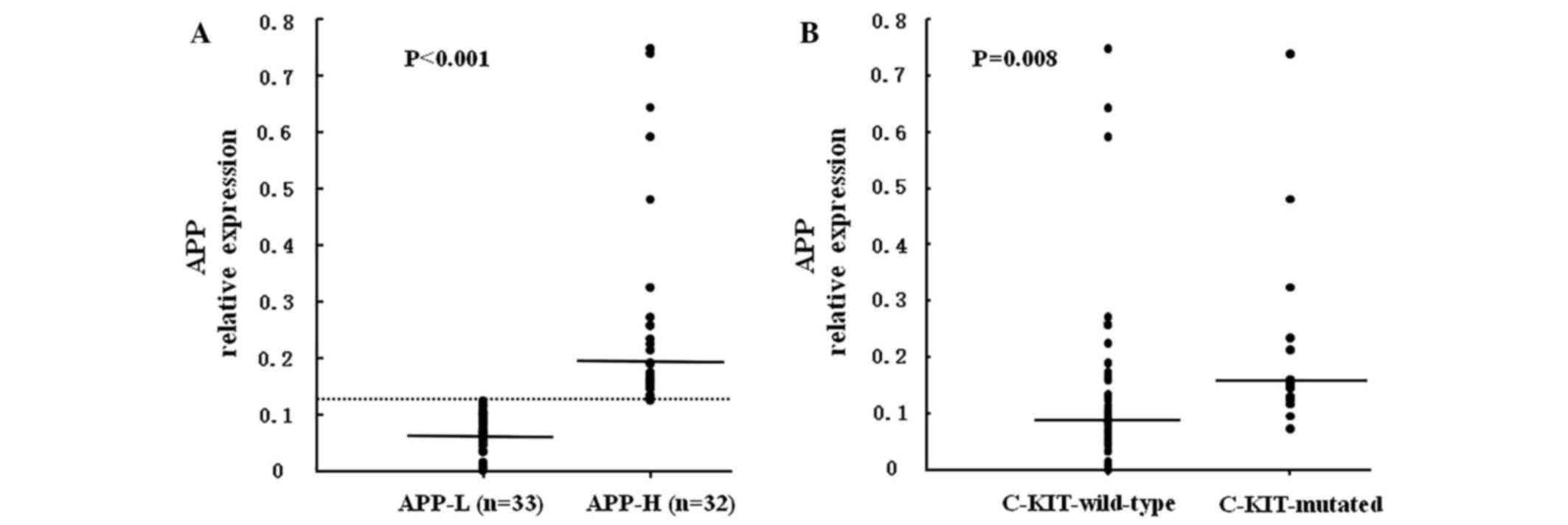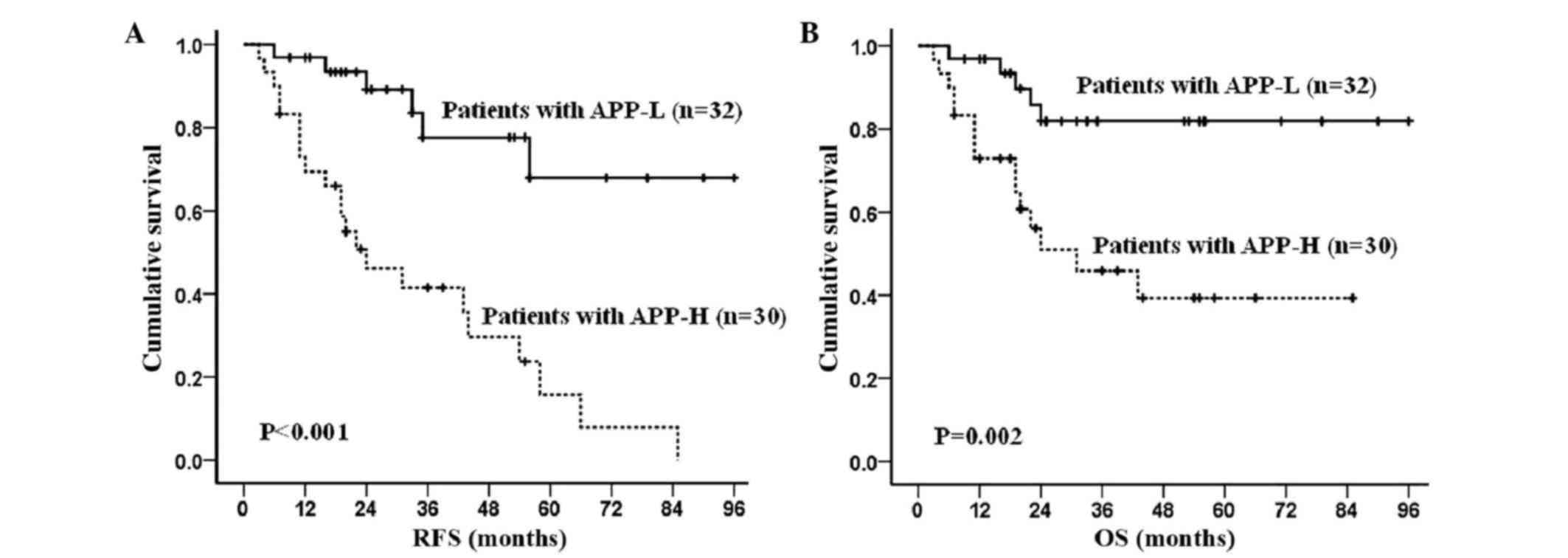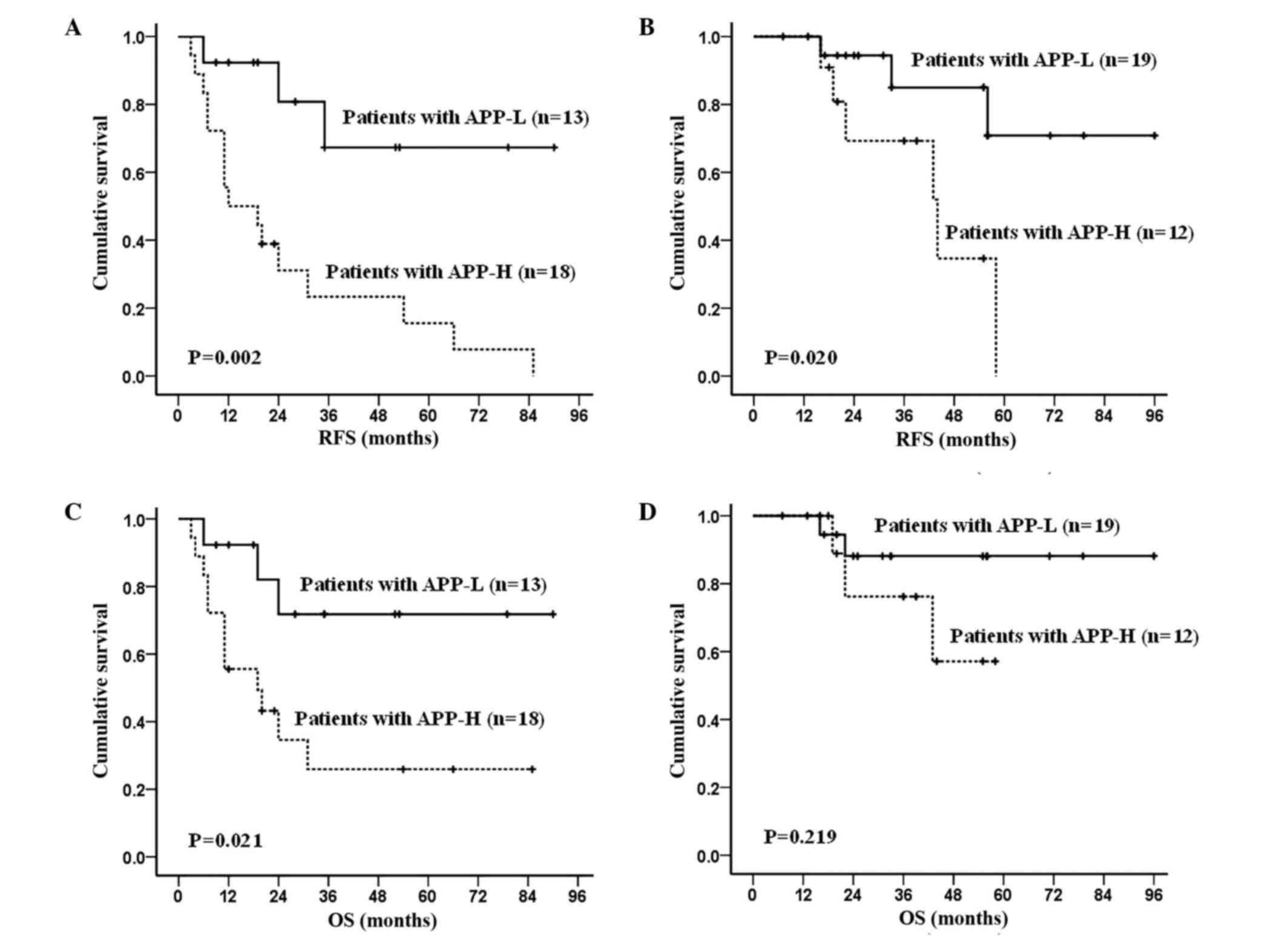|
1
|
Rowley JD: Identification of a
translocation with quinacrine fluorescence in a patient with acute
leukemia. Ann Genet. 16:109–112. 1973.PubMed/NCBI
|
|
2
|
Marcucci G, Mrózek K, Ruppert AS, Maharry
K, Kolitz JE, Moore JO, Mayer RJ, Pettenati MJ, Powell BL, Edwards
CG, et al: Prognostic factors and outcome of core binding factor
acute myeloid leukemia patients with t(8;21) differ from those of
patients with inv(16): A Cancer and Leukemia Group B study. J Clin
Oncol. 23:5705–5717. 2005. View Article : Google Scholar : PubMed/NCBI
|
|
3
|
Grimwade D, Hills RK, Moorman AV, Walker
H, Chatters S, Goldstone AH, Wheatley K, Harrison CJ and Burnett
AK; National Cancer Research Institute Adult Leukaemia Working
Group, : Refinement of cytogenetic classification in acute myeloid
leukemia: Determination of prognostic significance of rare
recurring chromosomal abnormalities among 5,876 younger adult
patients treated in the United Kingdom Medical Research Council
trials. Blood. 116:354–365. 2010. View Article : Google Scholar : PubMed/NCBI
|
|
4
|
Shimada A, Taki T, Tabuchi K, Tawa A,
Horibe K, Tsuchida M, Hanada R, Tsukimoto I and Hayashi Y: KIT
mutations, and not FLT3 internal tandem duplication, are strongly
associated with a poor prognosis in pediatric acute myeloid
leukemia with t(8;21): A study of the Japanese Childhood AML
Cooperative Study Group. Blood. 107:1806–1809. 2006. View Article : Google Scholar : PubMed/NCBI
|
|
5
|
Krauth MT, Eder C, Alpermann T, Bacher U,
Nadarajah N, Kern W, Haferlach C, Haferlach T and Schnittger S:
High number of additional genetic lesions in acute myeloid leukemia
with t(8;21)/RUNX1-RUNX1T1: Frequency and impact on clinical
outcome. Leukemia. 28:1449–1458. 2014. View Article : Google Scholar : PubMed/NCBI
|
|
6
|
Paschka P, Marcucci G, Ruppert AS, Mrózek
K, Chen H, Kittles RA, Vukosavljevic T, Perrotti D, Vardiman JW,
Carroll AJ, et al Cancer and Leukemia Group B, : Adverse prognostic
significance of KIT mutations in adult acute myeloid leukemia with
inv(16) and t(8;21): A Cancer and Leukemia Group B Study. J Clin
Oncol. 24:3904–3911. 2006. View Article : Google Scholar : PubMed/NCBI
|
|
7
|
Schnittger S, Kohl TM, Haferlach T, Kern
W, Hiddemann W, Spiekermann K and Schoch C: KIT-D816 mutations in
AML1-ETO-positive AML are associated with impaired event-free and
overall survival. Blood. 107:1791–1799. 2006. View Article : Google Scholar : PubMed/NCBI
|
|
8
|
Byrd JC, Weiss RB, Arthur DC, Lawrence D,
Baer MR, Davey F, Trikha ES, Carroll AJ, Tantravahi R, Qumsiyeh M,
et al: Extramedullary leukemia adversely affects hematologic
complete remission rate and overall survival in patients with t(8;2
1)(q22;q22): Results from Cancer and Leukemia Group B 8461. J Clin
Oncol. l5:1–475. 1997.
|
|
9
|
Zhang MY, Zheng CY, Zou MM, Zhu JW, Zhang
Y, Wang J, Liu CF, Li QF, Xiao ZC, Li S, et al: Lamotrigine
attenuates deficits in synaptic plasticity and accumulation of
amyloid plaques in APP/PS1 transgenic mice. Neurobiol Aging.
35:2713–2725. 2014. View Article : Google Scholar : PubMed/NCBI
|
|
10
|
Baldus CD, Liyanarachchi S, Mrózek K, Auer
H, Tanner SM, Guimond M, Ruppert AS, Mohamed N, Davuluri RV,
Caligiuri MA, et al: Acute myeloid leukemia with complex karyotypes
and abnormal chromosome 21: Amplification discloses overexpression
of APP ETS2, and ERG genes. Proc Natl Acad Sci USA. 101:pp.
3915–3920. 2004; View Article : Google Scholar : PubMed/NCBI
|
|
11
|
Wang W, Meng FY, Huang ZF, Huang M and Liu
LX: Expression and role of amyloid precursor protein gene in acute
myeloid leukemia. Zhonghua Xue Ye Xue Za Zhi. 31:309–314. 2010.(In
Chinese). PubMed/NCBI
|
|
12
|
Hansel DE, Rahman A, Wehner S, Herzog V,
Yeo CJ and Maitra A: Increased expression and processing of the
Alzheimer amyloid precursor protein in pancreatic cancer may
influence cellular proliferation. Cancer Res. 63:7032–7037.
2003.PubMed/NCBI
|
|
13
|
Ko SY, Lin SC, Chang KW, Wong YK, Liu CJ,
Chi CW and Liu TY: Increased expression of amyloid precursor
protein in oral squamous cell carcinoma. Int J Cancer. 111:727–732.
2004. View Article : Google Scholar : PubMed/NCBI
|
|
14
|
Krause K, Karger S, Sheu SY, Aigner T,
Kursawe R, Gimm O, Schmid KW, Dralle H and Fuhrer D: Evidence for a
role of the amyloid precursor protein in thyroid carcinogenesis. J
Endocrinol. 198:291–299. 2008. View Article : Google Scholar : PubMed/NCBI
|
|
15
|
Takayama K, Tsutsumi S, Suzuki T,
Horie-Inoue K, Ikeda K, Kaneshiro K, Fujimura T, Kumagai J, Urano
T, Sakaki Y, et al: Amyloid precursor protein is a primary androgen
target gene that promotes prostate cancer growth. Cancer Res.
69:137–142. 2009. View Article : Google Scholar : PubMed/NCBI
|
|
16
|
Jiang L, Yu G, Meng W, Wang Z, Meng F and
Ma W: Overexpression of amyloid precursor protein in acute myeloid
leukemia enhances extramedullary infiltration by MMP-2. Tumour
Biol. 34:629–636. 2013. View Article : Google Scholar : PubMed/NCBI
|
|
17
|
Swerdlow SH; International Agency for
Research on Cancer, and World Health Organization, : WHO
classification of tumours of haematopoietic and lymphoid tissues.
International Agency for Research on Cancer; Lyon, France: pp.
4392008
|
|
18
|
Bennett JM, Catovsky D, Daniel MT,
Flandrin G, Galton DA, Gralnick HR and Sultan C: Proposals for the
classification of the acute leukaemias. French-American-British
(FAB) co-operative group. Br J Haematol. 33:451–458. 1976.
View Article : Google Scholar : PubMed/NCBI
|
|
19
|
Gralnick HG, Galton DAG, Catovsky D,
Sultan D and Bennett JM: Classification of acute leukemia. Ann
Intern Med. 87:740–753. 1977. View Article : Google Scholar : PubMed/NCBI
|
|
20
|
Zhu HH, Zhang XHs, Qin YZ, Liu DH, Jiang
H, Chen H, Jiang Q, Xu LP, Lu J, Han W, et al: MRD-directed risk
stratification treatment may improve outcomes of t(8;21) AML in the
first complete remission: Results from the AML05 multicenter trial.
Blood. 121:4056–4062. 2013. View Article : Google Scholar : PubMed/NCBI
|
|
21
|
Beillard E, Pallisgaard N, van der Velden
VH, Bi W, Dee R, van der Schoot E, Delabesse E, Macintyre E,
Gottardi E, Saglio G, et al: Evaluation of candidate control genes
for diagnosis and residual disease detection in leukemic patients
using ‘real-time’ quantitative reverse-transcriptase polymerase
chain reaction (RQ-PCR) - a Europe against cancer program.
Leukemia. 17:2474–2486. 2003. View Article : Google Scholar : PubMed/NCBI
|
|
22
|
Reuss-Borst MA, Bühring HJ, Schmidt H and
Mülle CA: AML: Immunophenotypic heterogeneity and prognostic
significance of c-kit expression. Leukemia. 8:258–263.
1994.PubMed/NCBI
|
|
23
|
Haferlach C, Rieder H, Lillington DM,
Dastugue N, Hagemeijer A, Harbott J, Stilgenbauer S, Knuutila S,
Johansson B and Fonatsch C: Proposals for standardized protocols
for cytogenetic analyses of acute leukemias, chronic lymphocytic
leukemia, chronic myeloid leukemia, chronic myeloproliferative
disorders, and myelodysplastic syndromes. Genes Chromosomes Cancer.
46:494–499. 2007. View Article : Google Scholar : PubMed/NCBI
|
|
24
|
Shaffer LG, McGowan-Jordan J and Schmid M:
ISCN 2013: An International System for Human Cytogenetic
Nomenclature (2013). S. Karger AG; Basel: 2013, View Article : Google Scholar
|
|
25
|
Tsiatis AC, Norris-Kirby A, Rich RG, Hafez
MJ, Gocke CD, Eshleman JR and Murphy KM: Comparison of Sanger
sequencing, pyrosequencing, and melting curve analysis for the
detection of KRAS mutations: diagnostic and clinical implications.
J Mol Diagn. 12:425–432. 2010. View Article : Google Scholar : PubMed/NCBI
|
|
26
|
Leroy H, de Botton S, Grardel-Duflos N,
Darre S, Leleu X, Roumier C, Morschhauser F, Lai JL, Bauters F,
Fenaux P and Preudhomme C: Prognostic value of real-time
quantitative PCR (RQ-PCR) in AML with t(8;21). Leukemia.
19:367–372. 2005. View Article : Google Scholar : PubMed/NCBI
|
|
27
|
Steidl U, Kronenwett R, Rohr UP, Fenk R,
Kliszewski S, Maercker C, Neubert P, Aivado M, Koch J, Modlich O,
et al: Gene expression profiling identifies significant differences
between the molecular phenotypes of bone marrow-derived and
circulating human CD34+ hematopoietic stem cells. Blood.
99:2037–2044. 2002. View Article : Google Scholar : PubMed/NCBI
|
|
28
|
Park SH, Chi HS, Cho YU, Jang S and Park
CJ: Effects of c-KIT mutations on expression of the RUNX1/RUNX1T1
fusion transcript in t(8;21)-positive acute myeloid leukemia
patients. Leuk Res. 37:784–789. 2013. View Article : Google Scholar : PubMed/NCBI
|
|
29
|
Wichmann C, Quagliano-Lo Coco I, Yildiz Ö,
Chen-Wichmann L, Weber H, Syzonenko T, Döring C, Brendel C,
Ponnusamy K, Kinner A, et al: Activating c-KIT mutations confer
oncogenic cooperativity and rescue RUNX1/ETO-induced DNA damage and
apoptosis in human primary CD34+ hematopoietic
progenitors. Leukemia. 29:279–289. 2015. View Article : Google Scholar : PubMed/NCBI
|
|
30
|
Byrd JC, Dodge RK, Carroll A, Baer MR,
Edwards C, Stamberg J, Qumsiyeh M, Moore JO, Mayer RJ, Davey F, et
al: Patients with t(8;21)(q22;q22) and acute myeloid leukemia have
superior failure-free and overall survival when repetitive cycles
of high-dose cytarabine are administered. J Clin Oncol.
17:3767–375. 1999. View Article : Google Scholar : PubMed/NCBI
|
|
31
|
Nguyen S, Leblanc T, Fenaux P, Witz F,
Blaise D, Pigneux A, Thomas X, Rigal-Huguet F, Lioure B, Auvrignon
A, et al: A while blood cell index as the main prognostic factor in
t(8;21) acute myeloid leukemia(AML): A survey of l6l cases from the
French AML Intergroup. Blood. 99:3517–3523. 2002. View Article : Google Scholar : PubMed/NCBI
|













